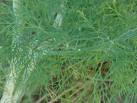 Dill or no dill? This was a the question that came to me when moving to Bulgaria. It was no dill in the UK and dill when I got here. Dill is used extensively in Bulgarian dishes. There is no stopping me now once I discovered it and grow it both in the town and village location.
Dill or no dill? This was a the question that came to me when moving to Bulgaria. It was no dill in the UK and dill when I got here. Dill is used extensively in Bulgarian dishes. There is no stopping me now once I discovered it and grow it both in the town and village location.It will be now surprise that Dill comes originally from Eastern Europe (Bulgaria included.) There are also varieties in Mediterranean and in West Asia. Dill was even found in the tomb of the Ancient Egyptian Amenhotep II, late Neolithic lakeshore settlements in Switzerland and in Roman ruins in the UK.
The name dill probably came from Norse or Anglo-Saxon word 'dylle' that translates 'to soothe.' The ancient Greeks saw dill as a sign of prosperity and it was used in 8th banquets to cure hiccups. In the middle-ages saw dill as a erotic love potion and to keep evil witches away. American Puritans and Quakers gave dill seeds to their children to chew during long church meetings as it acted as a hunger-suppressant.
 Dill has fernlike leaves, which are aromatic. These are used and are used to flavour a variety of foods including soups and pickles where the flowers of the dill are often used. Dill is best when used fresh due to it loosing its flavour very quickly. Modern freeze-dried dill leaves preserve their flavour well and will last up tot six months.
Dill has fernlike leaves, which are aromatic. These are used and are used to flavour a variety of foods including soups and pickles where the flowers of the dill are often used. Dill is best when used fresh due to it loosing its flavour very quickly. Modern freeze-dried dill leaves preserve their flavour well and will last up tot six months.The dill seed is used as a spice, with a flavour somewhat similar to caraway, but also resembling that of fresh or dried dill weed. Dill oil can be extracted from the leaves, stems and seeds of the plant. The seeds were traditionally used to soothe the stomach after meals.
Growing dill Successfully requires warm to hot summers with high sunshine levels; perfect in Bulgaria. Partial shade will reduce crop quality substantially. Dill likes rich, well-drained soil.
The seeds are gathered by cutting off the flower heads, as the seed is begins to ripen. The seed heads are placed upside down in a paper bag and left. The seeds then separate from the stems easily for storage in an airtight container. It is very easy to manage.
Dill is great is grow in containers. You can use normal potting compost and keep the plants well watered. You can easily grow dill indoors, just sow the seeds October in small pots then transplant them to larger pots when the plants are about over 15 cm in height. A sunny windowsill is an ideal place for them to grow on although you might need a stake to support them eventually The crop will be ready for harvest about tow months after sowing.
This Dill Sauce recipe was tried and tested from the BBC and was found to be superb especially served with fish dishes.
Dill Sauce Recipe
Ingredients:
15g/½oz sugar
200ml/7fl oz red wine vinegar
80g/3oz Dijon mustard
400ml/14½fl oz olive oil
salt and freshly ground black pepper
2 large tbsp fresh dill, chopped
 Method:
Method:1. Whisk the sugar, vinegar and mustard together in a bowl.
2. Slowly whisk in the oil until smooth and thickened.
3. Season, to taste, with salt and freshly ground black pepper and add the dill.
Recipe from www.bbc.co.uk/


![Reblog this post [with Zemanta]](http://img.zemanta.com/reblog_b.png?x-id=cb21ceb7-a29c-446f-8a11-83474f202b7d)

![Reblog this post [with Zemanta]](http://img.zemanta.com/reblog_b.png?x-id=463902be-4803-4d5f-a725-bf625135bf33)



![Reblog this post [with Zemanta]](http://img.zemanta.com/reblog_b.png?x-id=c322d032-dc2e-4e28-8333-e882318b30ea)


![Reblog this post [with Zemanta]](http://img.zemanta.com/reblog_b.png?x-id=e4b01790-a817-4bf8-987a-3885469c9507)


![Reblog this post [with Zemanta]](http://img.zemanta.com/reblog_e.png?x-id=9de067f2-6dce-40b6-a465-07b5ec87ef8a)